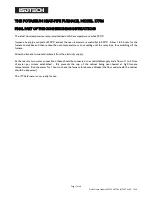
Page 15 of 40
Dual Furnace Models M17705, N17706 & 17707 Iss.09 – 12/14
NEXT GENERATION CALIBRATION APPARATUS FOR INDIUM AND TIN
FIXED POINTS
INTRODUCTION
Before calibrating a standard platinum resistance thermometer, it is usual to check its water triple point resistance
value and then to anneal the thermometer. The annealing temperature varies typically between 400 and 700°C.
DESCRIPTION
The new calibration apparatus developed by Isotech not only allows you to create and maintain the ITS 90 freezing
points of Indium and Tin using a water heat-pipe, but also provides a second furnace for annealing thermometers at
temperatures up to 700°C.
Complementary features of the apparatus are a pre-heating tube, maintained at the cell temperature, and a rack for
storage of up to 4 thermometers at approximately ambient temperature.
METHOD OF OPERATION
1.
By adjusting the set-point to a few degrees above the appropriate melting point, the cell, (tin or indium) is
melted in the essentially temperature-gradient-free water-filled heat-pipe. When the cell's contents are
completely melted, the heat-pipe temperature is re-adjusted to a level 0.5°C below the freeze temperature
of the cell. When this set-point has been reached, a cold rod is introduced into the re-entrant tube of the cell
to initiate the freeze, giving a plateau that can be maintained for between 12 and 24 hours. A modified
technique is appropriate for tin, in the form of an applied thermal shock to the whole cell to counteract the
tendency for a slow, large undercool to occur.
2.
The thermometers are removed from their rack and, assuming they have already been annealed and are
stable, are placed successively in the pre-warming tube for 5 minutes and then transferred to the cell for
calibration. After 20 to 30 minutes the thermometer can be removed slowly from the cell and, after cooling
to room temperature, the R
TPW
-value can be checked.






























